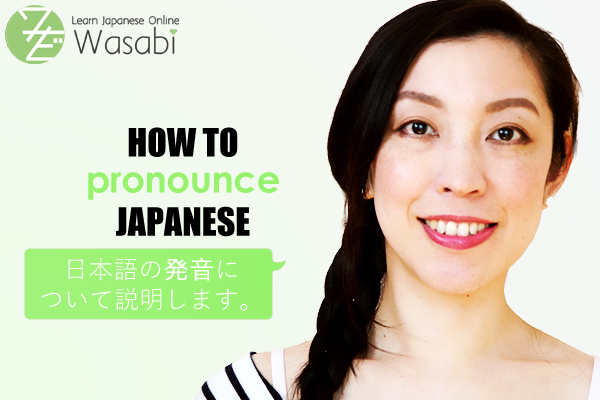How to pronounce Japanese
Welcome back to another “Video & Article” series with tutor Wakako. In this article and video we will take a look at how to pronounce Japanese properly. No matter whether your native language is English or another language, there will probably be many fundamental differences in how your mother tongue and Japanese are pronounced. Today, we will explain how Japanese is pronounced by contrasting it with standard English pronunciation.
| Table of Contents [Consonants & Vowels] [Highs and lows instead of accents] |
[Consonants & Vowels]
One of the major differences between English and Japanese pronunciation is that most of the sounds in Japanese consist of a set of a consonant and a vowel. There are only few cases where a consonant is pronounced without a partner vowel in Japanese. Let’s take a look at two examples:
りんご
ri n go
オレンジ
ore n ji
Each syllable in these examples consists of a consonant and a corresponding vowel (r + i, g + o, o (standalone vowel), r + e, j+ i) except for the consonant “n”. “N” is an exception and can be pronounced as a standalone consonant.
Other exceptions are “a, i, u, e, o”, which are standalone vowels.
Here are some more examples:
[adsense]
こんにちは
Ko n ni chi wa
元気ですか?
Ge n ki de su ka?
[Highs and lows instead of accents]
How to accentuate words is also different from English. English words have accents, and accented sounds are pronounced longer and more strongly. However, the Japanese language doesn’t have such an accent system. Instead, words are pronounced higher or lower, but every syllable has an equal strength and length in its pronunciation.
So, every word in Japanese has high parts and low parts.
↘ indicates that the following part of the word is low. ↗ indicates that the following part of the word has high pronunciation.
病院
↘びょ↗ういん
美容院
↘び↗よ↘ういん
郵便局
↘ゆ↗うび↘んきょく
デパート
↘で↗ぱ↘ーと
スーパー
↗す↘ーぱー
軽い
↘か↗るい
重い
↘お↗もい
美味しい
↘お↗いし↘い
Other words are entirely the same words, and can only be distinguished by their high/low pronunciation and of course their Kanji.
箸
↗は↘し
Chopsticks
橋
↘は↗し
Bridge
柿
↘か↗き
Kaki (Japanese persimmon)
牡蛎
↗か↘き
Oyster
着る
↘き↗る
To wear
切る
↗き↘る
To cut
Another character of Japanese pronunciation is that every sound is pronounced at an equal length. Therefore, for example “オレンジ” is pronounced in four equal syllables. This is different from English, which has long and strong sounds and short and weak sounds.
If you apply the English accent system such as strong and long accents to Japanese words, it sounds a bit awkward and sometimes may even sound like an entirely different word.
For example, my name is Wakako and it is pronounced “↗wa ↘ka ↘ko” in Japanese. It has a high- low- low pitch and every sound is pronounced equally long. If you apply the English accent system to my name, it sounds like waKAkou. That makes it sound very different, and not like a Japanese name at all.
If you master the Japanese high and low pitch pronunciation, your speaking Japanese will sound very natural and you will have a much easier time being understood by Japanese people.
That is all for today’s lesson. If you have any questions you can always clear them up by booking a lesson with one of our native Japanese tutors. See you next time!
| 発音 | Pronunciation |
| 病院 | Hospital |
| 美容院 | Beauty Parlor |
| 郵便局 | Post office |
| デパート | Department store |
| スーパー | Supermarket |
| 軽い | Light |
| 重い | Heavy |
| 美味しい | Delicious |
| 箸 | Chopsticks |
| 橋 | Bridge |
| 柿 | JApanese persimmon |
| 牡蛎 | Oyster |
| 着る | To wear |
| 切る | To cut |




